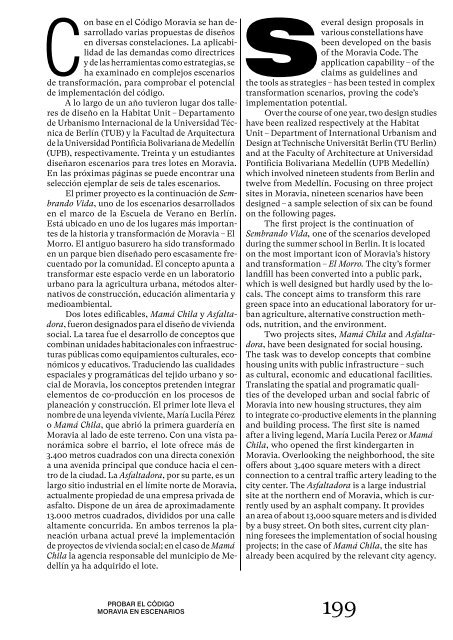Moravia Manifesto – Coding Strategies for Informal Neighborhoods
ISBN 978-3-86859-535-2 https://www.jovis.de/en/books/details/product/moravia-manifesto.html
ISBN 978-3-86859-535-2
https://www.jovis.de/en/books/details/product/moravia-manifesto.html
- No tags were found...
You also want an ePaper? Increase the reach of your titles
YUMPU automatically turns print PDFs into web optimized ePapers that Google loves.
Con base en el Código <strong>Moravia</strong> se han desarrollado<br />
varias propuestas de diseños<br />
en diversas constelaciones. La aplicabilidad<br />
de las demandas como directrices<br />
y de las herramientas como estrategias, se<br />
ha examinado en complejos escenarios<br />
de trans<strong>for</strong>mación, para comprobar el potencial<br />
de implementación del código.<br />
A lo largo de un año tuvieron lugar dos talleres<br />
de diseño en la Habitat Unit <strong>–</strong> Departamento<br />
de Urbanismo Internacional de la Universidad Técnica<br />
de Berlín (TUB) y la Facultad de Arquitectura<br />
de la Universidad Pontificia Bolivariana de Medellín<br />
(UPB), respectivamente. Treinta y un estudiantes<br />
diseñaron escenarios para tres lotes en <strong>Moravia</strong>.<br />
En las próximas páginas se puede encontrar una<br />
selección ejemplar de seis de tales escenarios.<br />
El primer proyecto es la continuación de Sembrando<br />
Vida, uno de los escenarios desarrollados<br />
en el marco de la Escuela de Verano en Berlín.<br />
Está ubicado en uno de los lugares más importantes<br />
de la historia y trans<strong>for</strong>mación de <strong>Moravia</strong> <strong>–</strong> El<br />
Morro. El antiguo basurero ha sido trans<strong>for</strong>mado<br />
en un parque bien diseñado pero escasamente frecuentado<br />
por la comunidad. El concepto apunta a<br />
trans<strong>for</strong>mar este espacio verde en un laboratorio<br />
urbano para la agricultura urbana, métodos alternativos<br />
de construcción, educación alimentaria y<br />
medioambiental.<br />
Dos lotes edificables, Mamá Chila y Asfaltadora,<br />
fueron designados para el diseño de vivienda<br />
social. La tarea fue el desarrollo de conceptos que<br />
combinan unidades habitacionales con infraestructuras<br />
públicas como equipamientos culturales, económicos<br />
y educativos. Traduciendo las cualidades<br />
espaciales y programáticas del tejido urbano y social<br />
de <strong>Moravia</strong>, los conceptos pretenden integrar<br />
elementos de co-producción en los procesos de<br />
planeación y construcción. El primer lote lleva el<br />
nombre de una leyenda viviente, María Lucila Pérez<br />
o Mamá Chila, que abrió la primera guardería en<br />
<strong>Moravia</strong> al lado de este terreno. Con una vista panorámica<br />
sobre el barrio, el lote ofrece más de<br />
3.400 metros cuadrados con una directa conexión<br />
a una avenida principal que conduce hacia el centro<br />
de la ciudad. La Asfaltadora, por su parte, es un<br />
largo sitio industrial en el límite norte de <strong>Moravia</strong>,<br />
actualmente propiedad de una empresa privada de<br />
asfalto. Dispone de un área de aproximadamente<br />
13.000 metros cuadrados, divididos por una calle<br />
altamente concurrida. En ambos terrenos la planeación<br />
urbana actual prevé la implementación<br />
de proyectos de vivienda social; en el caso de Mamá<br />
Chila la agencia responsable del municipio de Medellín<br />
ya ha adquirido el lote.<br />
Several design proposals in<br />
various constellations have<br />
been developed on the basis<br />
of the <strong>Moravia</strong> Code. The<br />
application capability <strong>–</strong> of the<br />
claims as guidelines and<br />
the tools as strategies <strong>–</strong> has been tested in complex<br />
trans<strong>for</strong>mation scenarios, proving the code’s<br />
implementation potential.<br />
Over the course of one year, two design studies<br />
have been realized respectively at the Habitat<br />
Unit <strong>–</strong> Department of International Urbanism and<br />
Design at Technische Universität Berlin (TU Berlin)<br />
and at the Faculty of Architecture at Universidad<br />
Pontificia Bolivariana Medellín (UPB Medellín)<br />
which involved nineteen students from Berlin and<br />
twelve from Medellín. Focusing on three project<br />
sites in <strong>Moravia</strong>, nineteen scenarios have been<br />
designed <strong>–</strong> a sample selection of six can be found<br />
on the following pages.<br />
The first project is the continuation of<br />
Sembrando Vida, one of the scenarios developed<br />
during the summer school in Berlin. It is located<br />
on the most important icon of <strong>Moravia</strong>’s history<br />
and trans<strong>for</strong>mation <strong>–</strong> El Morro. The city’s <strong>for</strong>mer<br />
landfill has been converted into a public park,<br />
which is well designed but hardly used by the locals.<br />
The concept aims to trans<strong>for</strong>m this rare<br />
green space into an educational laboratory <strong>for</strong> urban<br />
agriculture, alternative construction methods,<br />
nutrition, and the environment.<br />
Two projects sites, Mamá Chila and Asfaltadora,<br />
have been designated <strong>for</strong> social housing.<br />
The task was to develop concepts that combine<br />
housing units with public infrastructure <strong>–</strong> such<br />
as cultural, economic and educational facilities.<br />
Translating the spatial and programatic qualities<br />
of the developed urban and social fabric of<br />
<strong>Moravia</strong> into new housing structures, they aim<br />
to integrate co-productive elements in the planning<br />
and building process. The first site is named<br />
after a living legend, María Lucila Perez or Mamá<br />
Chila, who opened the first kindergarten in<br />
<strong>Moravia</strong>. Overlooking the neighborhood, the site<br />
offers about 3,400 square meters with a direct<br />
connection to a central traffic artery leading to the<br />
city center. The Asfaltadora is a large industrial<br />
site at the northern end of <strong>Moravia</strong>, which is currently<br />
used by an asphalt company. It provides<br />
an area of about 13,000 square meters and is divided<br />
by a busy street. On both sites, current city planning<br />
<strong>for</strong>esees the implementation of social housing<br />
projects; in the case of Mamá Chila, the site has<br />
already been acquired by the relevant city agency.<br />
PROBAR EL CÓDIGO<br />
MORAVIA EN ESCENARIOS<br />
199


















